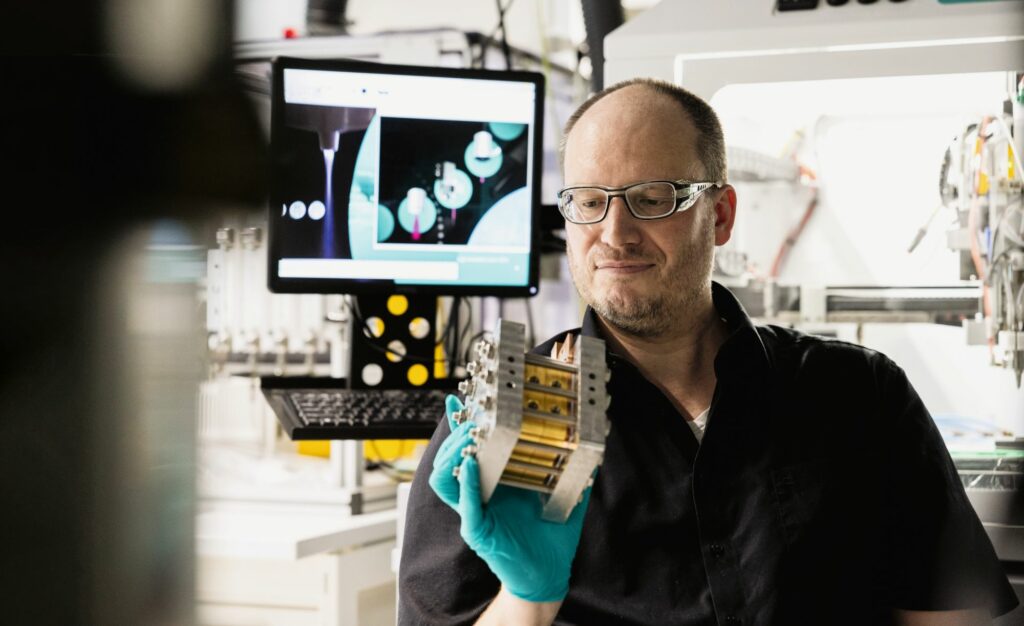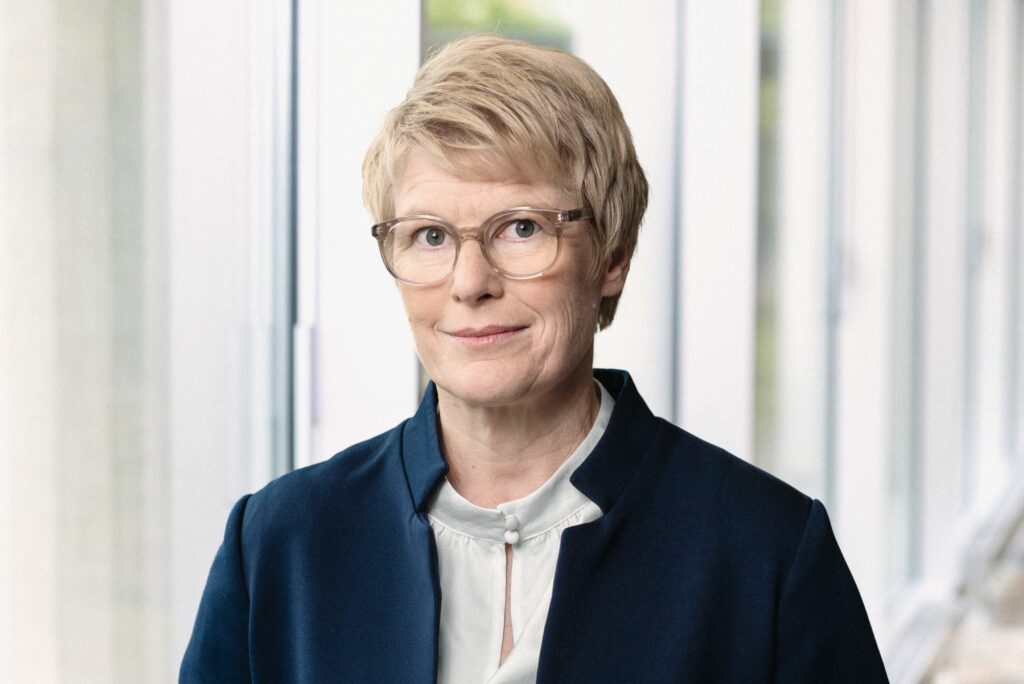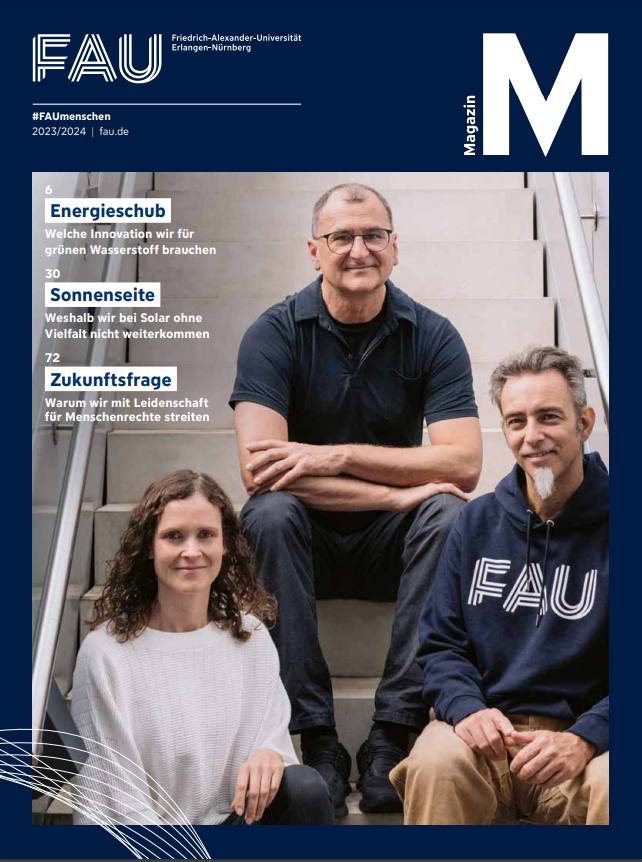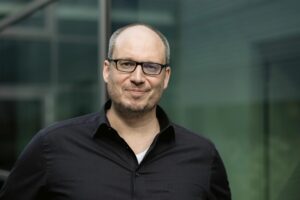More hydrogen!

Marion Merklein, Simon Thiele and their contribution to the energy transition
If the energy transition is to be a success, we need sources of green hydrogen and efficient technologies to use the energy it contains. Mechanical engineer Marion Merklein and process engineering specialist Simon Thiele are researching this field. An interview.
Prof. Merklein, Prof. Thiele, what have you got to do with hydrogen?
Marion Merklein: My field of research is the interface between materials science and mechanical engineering. It involves the forming and mechanical joining processes of metal workpieces such as riveting and shear clinching. Hydrogen is an important topic for me, because I would like to optimize both the development and large-scale production of fuel cells.
Simon Thiele: I work on improving existing electrochemical converters and researching completely new ones. These electrochemical converters are systems such as electrolyzers for manufacturing hydrogen from electricity and water or fuel cells for converting hydrogen into electrical energy further down the line.
Electrolyzers and fuel cells are already in operation. What are the biggest challenges at the moment?
Simon Thiele: The performance of our systems is currently not satisfactory and the costs are also too high. The price of hydrogen needs to go down drastically if we want to make this a success. The USA has set the ambitious goal of bringing the price of hydrogen down to only one dollar per kilo within the next decade. And fuel cells must also become cheaper.
How can this be done?
Simon Thiele: By increasing the efficiency of the processes involved. In addition, future large-scale production must provide significant cost advantages. My working group is carrying out intensive research on new materials and processes, such as the membrane electrode assembly, which plays a central role in both electrolyzers and in fuel cells. At the same time, we need to keep an eye on the overall costs. Electrolysis with acidic polymer electrolyte membranes requires iridium – a very rare and therefore very expensive precious metal. Alkaline electrolyzers could be an alternative, which allow for non-precious metals to be used as catalysts. We are also investigating whether the performance of such converters can be increased by increasing the operating temperature.

Ms Merklein, what contribution can you make as a materials forming specialist?
Marion Merklein: At the heart of every fuel cell there are something known as bipolar plates, which are ribbed metal plates joined in mirror symmetry. This produces channels that are separated from each other through which hydrogen and oxygen flow, the raw materials for the catalytic reaction. These plates are 700 by 700 millimeters in size and are almost as thin as a piece of aluminum foil. However, these plates still have to be stable enough so that a large number of them can be stacked next to each other in the fuel cell with exactly the same distance between them. As you can imagine, this is quite a challenge.
How do you overcome this challenge?
Marion Merklein: One the one hand with the correct material – we’re currently looking at titanium, but also steel and aluminum as cheaper alternatives. And of course, the shape of the workpiece plays a decisive role. Corrugating the foil increases its stability – just like when you fold a piece of paper in the same way. This is just the first step, however. Being able to reproduce this process at high speed with minimal tolerances is decisive for subsequent volume production. This means we are not only looking at the shape of the plates, but we will shortly set up a complete production line for fuel cells at laboratory scale.
When will we see the results of your research on the road or on rails?
Marion Merklein: If we want to make noticeable progress with the use of hydrogen in the mobility sector, we need a level of technology that corresponds to that of the internal combustion engine. We are at least 10 years away from achieving this. But we are working on closing the gap.
by Matthias Münch
High hopes for hydrogen
We will not achieve climate neutrality without hydrogen. “Batteries are the most economical solution for automobiles and light vehicles,” says Prof. Dr. Veronika Grimm, member of the German Council of Economic Experts and Chair of Economic Theory at FAU. “However, in the medium term, hydrogen will play a major role for heavier vehicles such as trucks and construction vehicles.” According to Grimm, green hydrogen will not only become increasingly important in the mobility sector, but also above all in industry and as a source of heat and electricity suitable for covering base load demand. As a member of the German National Hydrogen Council and member of the board of the Bavarian Hydrogen Center (H2.B), she is directly involved in the plans of the Federal Government and the Government of Bavaria for establishing a sustainable hydrogen economy.

Wirtschaft/Andreas Varnhorn)
Grimm: “We must do everything in our power to push innovative technologies forward while establishing stable international partnerships. Germany will not be able to meet its future demand for green hydrogen by itself.” New concepts are required for safely importing hydrogen, such as the LOHC technology developed at FAU.
This article is part of the FAU Magazin
 A university thrives because of the people who research, study, teach and work there. A university is supported by people who are connected to it as alumni, friends and sponsors and who are committed to promoting its interests all over the world.
A university thrives because of the people who research, study, teach and work there. A university is supported by people who are connected to it as alumni, friends and sponsors and who are committed to promoting its interests all over the world.
They all contribute their unique talents, skills and perspectives. It is this diversity that makes our FAU a place of innovation, a place where many talented individuals tackle the major challenges of our times together, and a place where they keep finding answers.
Read more articles online Download: FAU Magazin (PDF)

